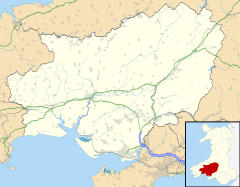Llangain
Llangain
|
|
|---|---|
 Capel Smyrna, Llangain |
|
| Llangain shown within Carmarthenshire | |
| Population | 573 (2011 Census) |
| OS grid reference | SN385155 |
| Community |
|
| Principal area | |
| Ceremonial county | |
| Country | Wales |
| Sovereign state | United Kingdom |
| Post town | CARMARTHEN |
| Postcode district | SA33 |
| Dialling code | 01267 |
| Police | Dyfed-Powys |
| Fire | Mid and West Wales |
| Ambulance | Welsh |
| EU Parliament | Wales |
| UK Parliament | |
| Welsh Assembly | |
Llangain is a community and village in Carmarthenshire, in the south-west of Wales. Located to the west of the River Towy, the community contains three standing stones, and two chambered tombs as well as the ruins of 15th century great house, Castell Moel. In 2001 the community's population was recorded at 574, decreasing slightly to 573 at the 2011 census.
Situated near the bank of the Afon Tywi, the parish extends from near Johnstown to Llansteffan in one direction and from Llangynog to the river in another and consists of very pleasant countryside with gentle hills reaching 350 ft/105m (Trig Point) and stretches of woodlands. The parish encloses an area of almost 3,000 acres (12 km2). Prehistory There are a few cromlechs or dolmens, the best examples being Meini Llwydion (Greystones) and Merlin's Quoits. They were communal burial places for family groups dating back to the Neolithic period (c.3000 BC).
The community is bordered by the communities of: Carmarthen; Llandyfaelog; Llansteffan; and Llangynog, all being in Carmarthenshire.
In 1846 the only school was a Sunday School. Llangain Board School was built in 1875 and officially opened in 1876, and was in use until superseded by the new school in 1977, to which only about 30-35 children go. There was an after school club but it closed down because not enough children went.
The present church of St Cain was built in 1871. There is a tiled mural on either side of the altar in memory of the Gwyn family of Pilroath and Plas Cwrthir. An Elizabethan chalice is dated 1576.
Capel Smyrna, a congregational chapel, is a prominent landmark within the parish. Originally built in 1835, it was rebuilt in 1865 and restored in 1915. The white building provided stabling for horses during chapel services. The loft served as the vestry.
Castell Moel (Green Castle) is a local landmark at the sharp bend on the B4312. The ruins of the impressive, late medieval residence still stand. It was never a castle but a residence built for the Reed family in the early 15th century and was in ruin in Elizabethan times. It is possible there had been some earthen fortification there at one time. Some believe this to be at Old Castle. Doubtless this would have been a motte and bailey. Until recent times ships used to lie at anchor below to off load onto lighter vessels for transport to Carmarthen.
...
Wikipedia

